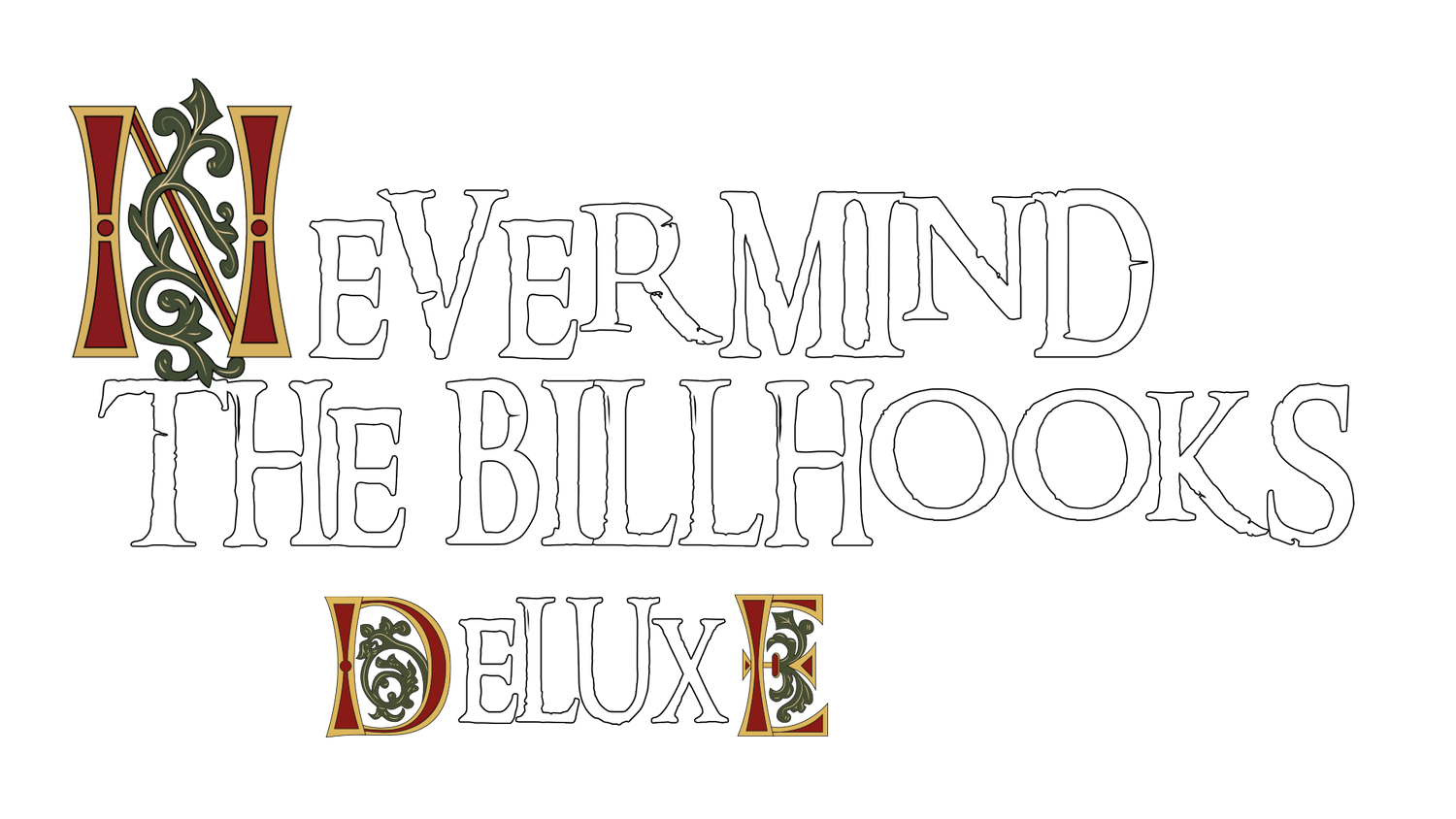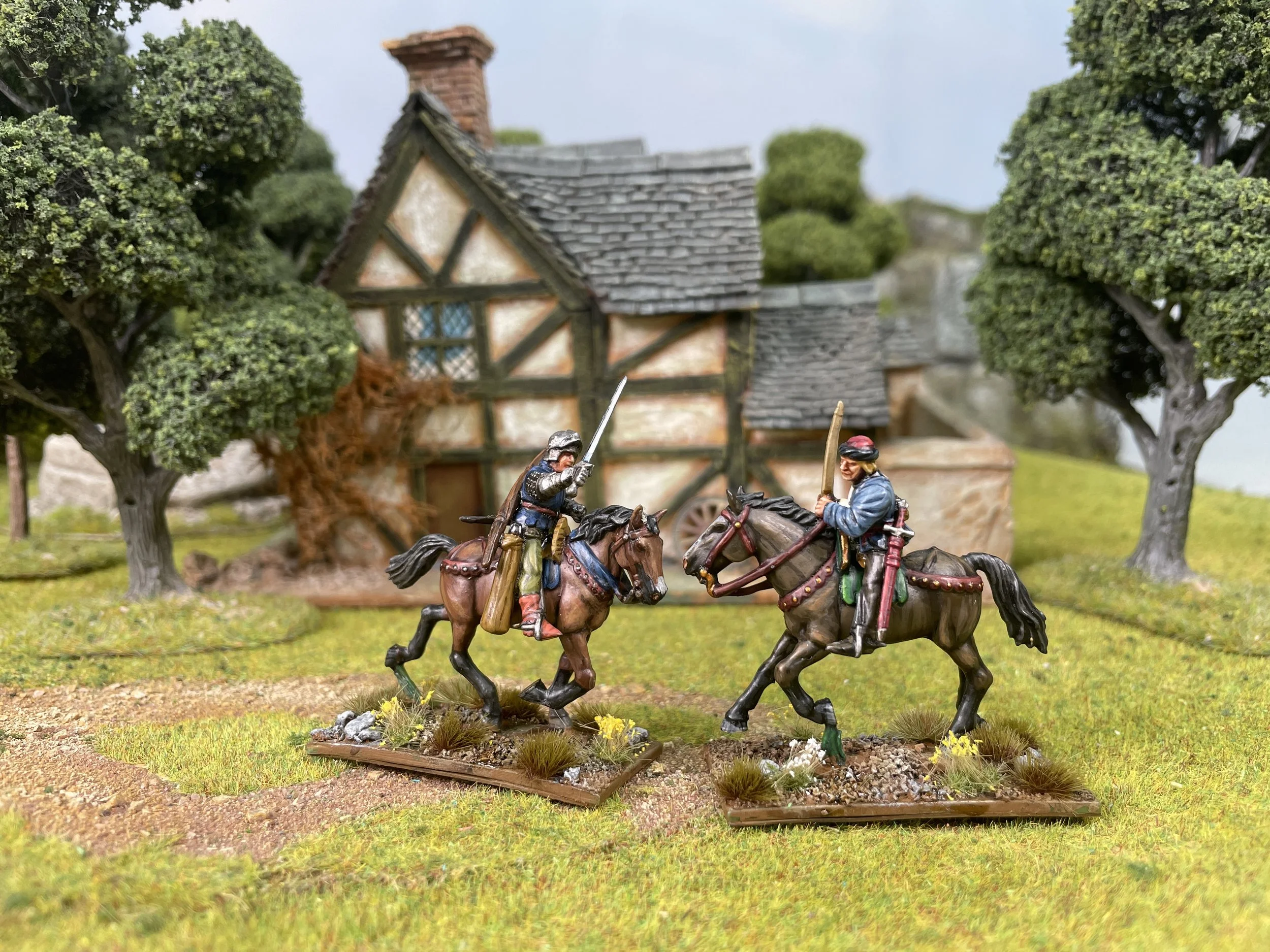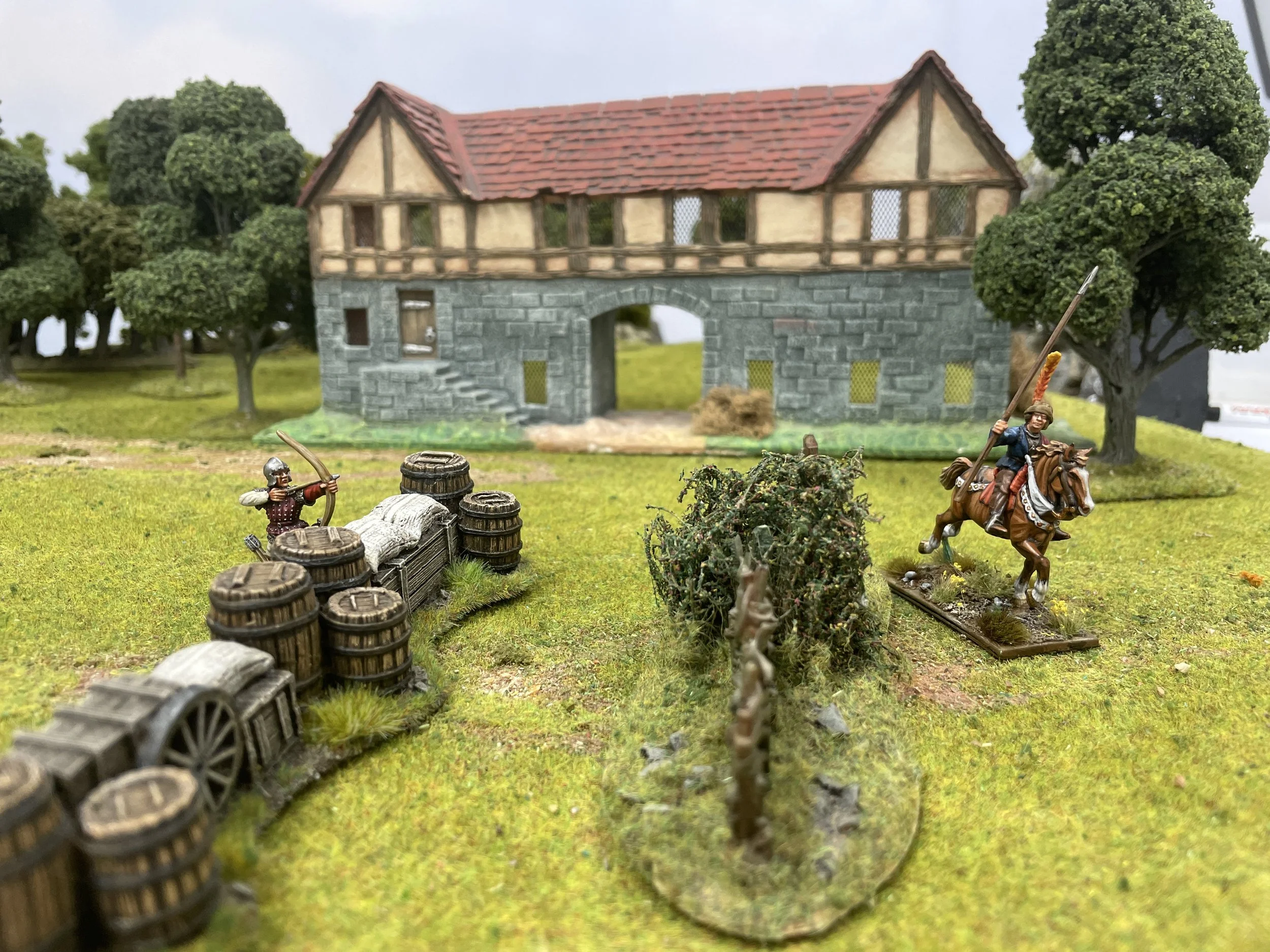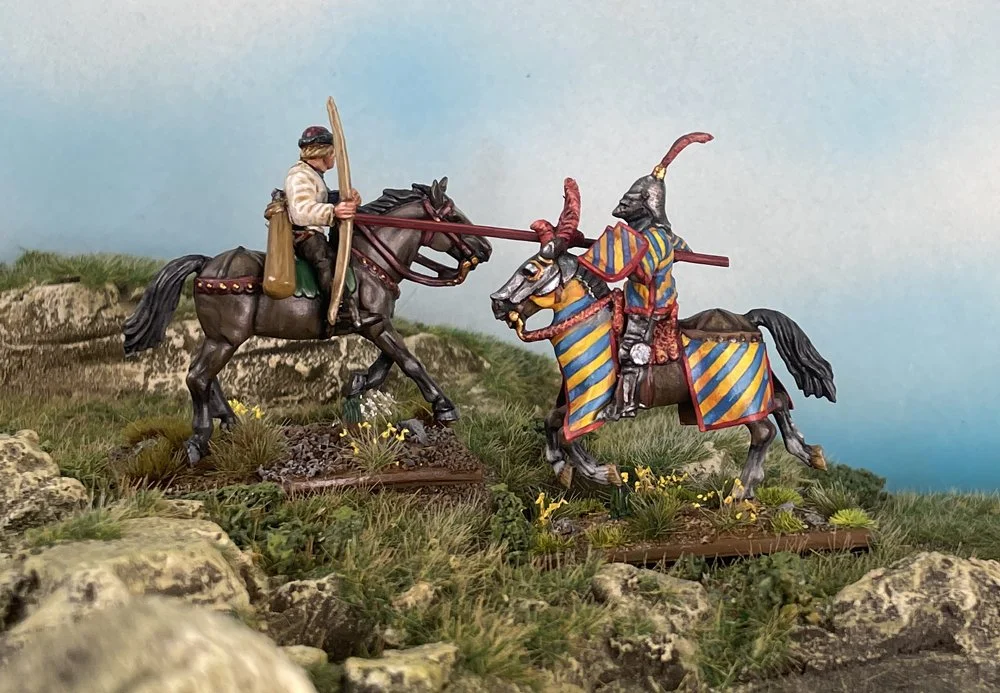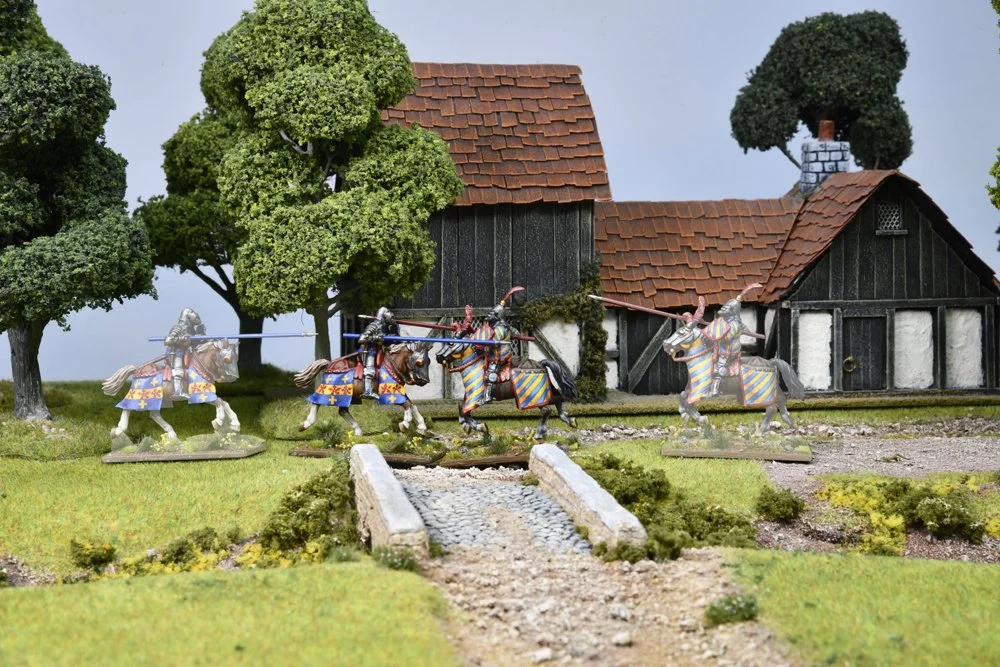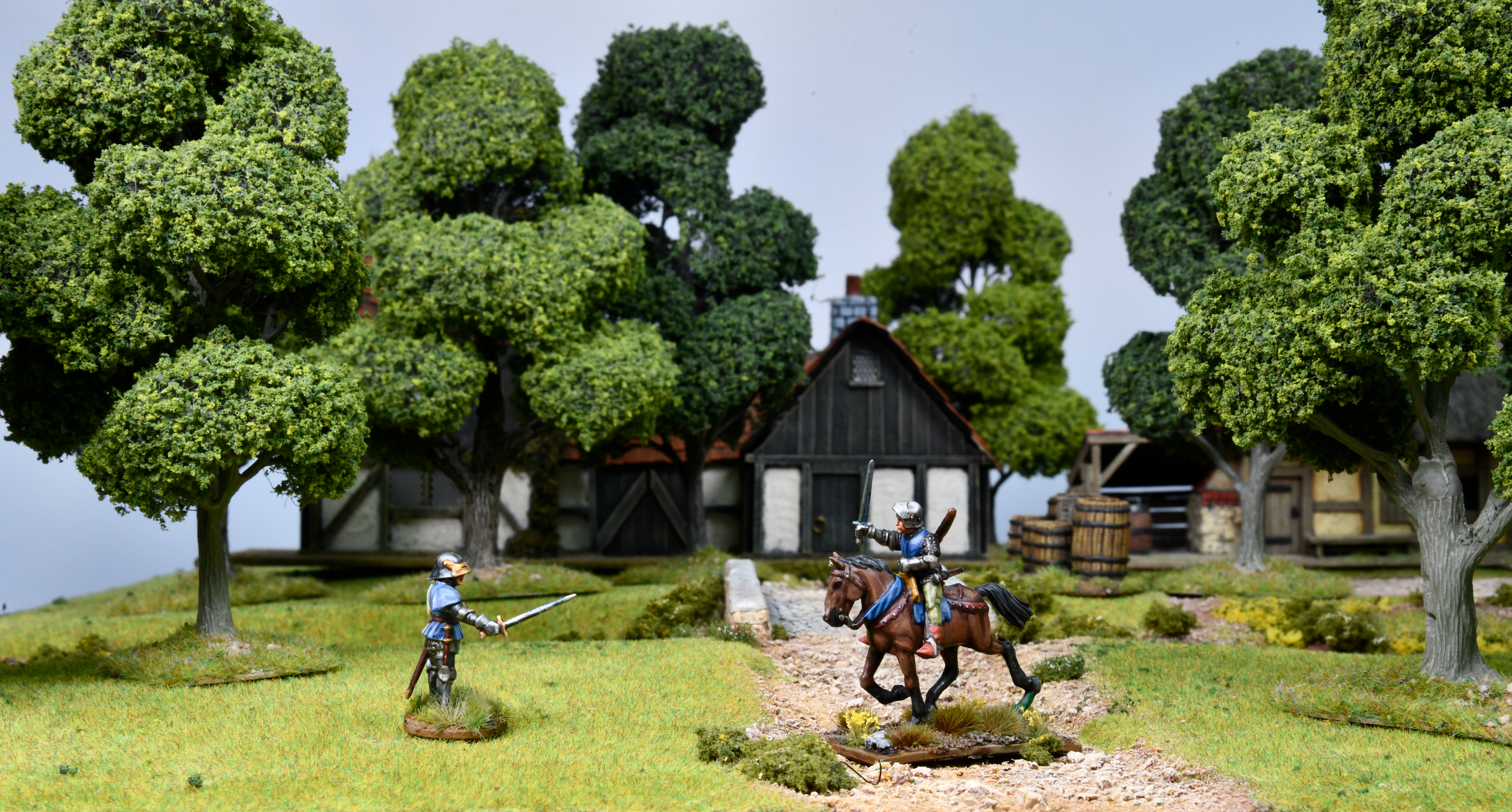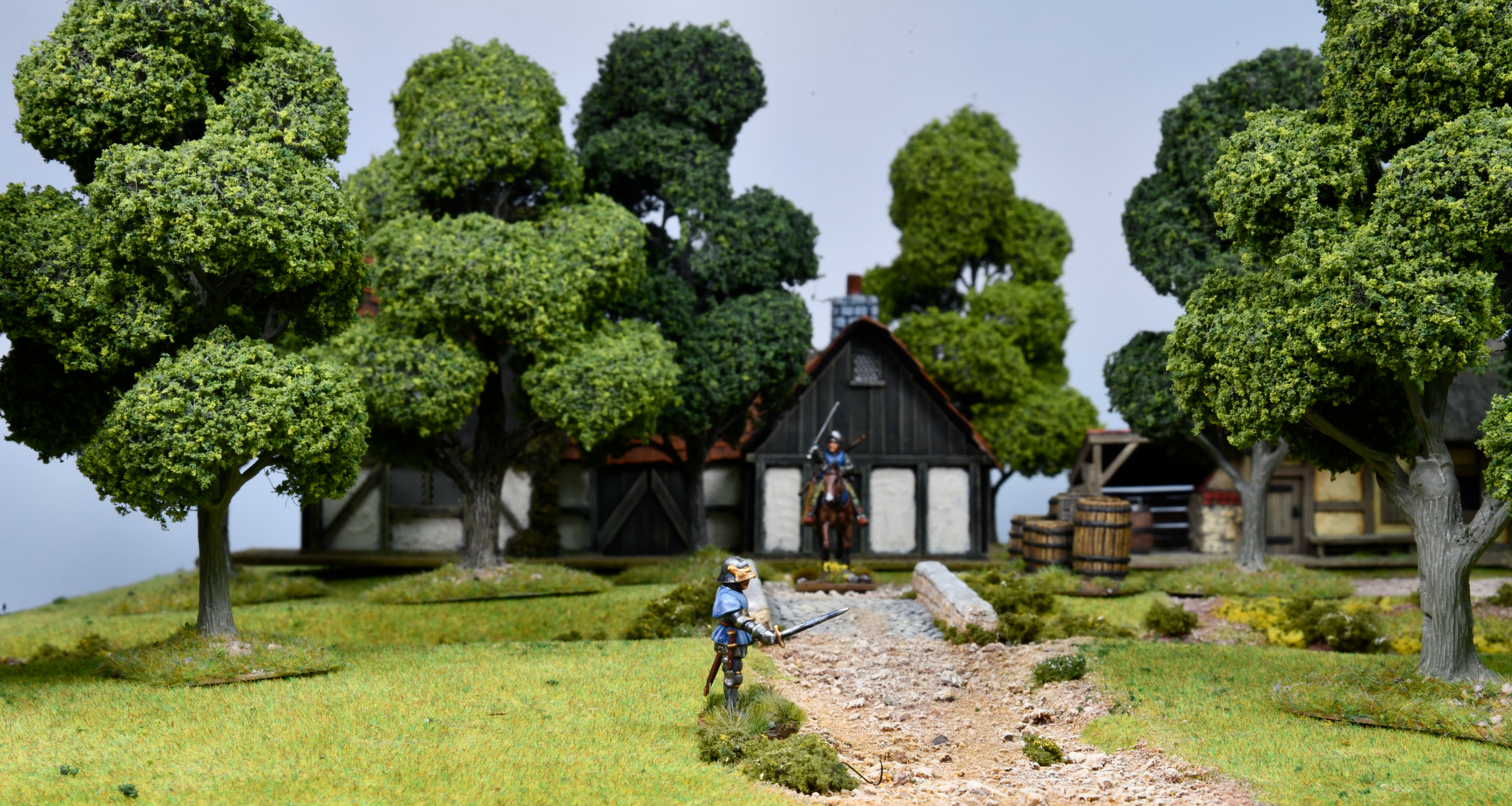My Kingdom for a Horse
Mike Peters presents rules for mounted characters in Ruckus, his Medieval skirmish game.
The mounted warrior dominated the Medieval battlefield, with knights learning to ride at a very early age and rarely out of the saddle. These skilled horsemen were able to leap, fully armoured, into the saddle and ride at full gallop over broken countryside, vaulting over fences and ditches with ease. Mounted Characters bring a whole new dimension to Ruckus, and in this article, I list everything you need to bring not just knights, but riders of all kinds to your gaming.
Types of Steed
The Warhorse
The Destrier and the Courser were both ridden into battle in the Medieval period, and for Ruckus purposes, they are combined under the title of Warhorse. The Captain, Squires, and the Light Cavalry, referred to as Scurrers or Prickers, all ride Warhorses.
Warhorses have 2 Health and therefore can be wounded once before being killed.
In Ruckus, Fighters are mounted on Warhorses.
Warhorse 1.
Warhorse 2.
The Nag
The Palfrey and Rouncey are more general-purpose riding horses, such as might be used by mounted infantry, camp followers, etc. For Ruckus purposes, they are combined under the title of Nag.
Nags have 2 Health and therefore can be wounded once before being killed.
In Ruckus, Shootists are mounted on Nags.
The Nag.
Beast of Burden
An ass, packhorse, or mule; not steeds in the traditional sense, perhaps, but they are used in some scenarios.
Beasts of Burden have 1 health.
Beast of Burden
Mounted Heroes
Captains and Squires who are mounted may be armed with Lances (see Mounted Charges with a Warhorse).
They can see and shout further atop their steed, so their Command Range is three times their Prowess. If they Dismount or are forcibly Dismounted, their Command Range returns to normal.
Heroes have trained with Warhorses and automatically acquire the Equestrian skill when mounted.
Equestrian - May reroll any Jump tests (see Crossing Obstacles).
Mounted Retainers
Retainers mounted on Warhorses react differently when they are Feckless. The mounted warriors of the medieval world were notoriously undisciplined, and their Feckless table reflects this.
Feckless on a Warhorse
5+ “As My Lord Commands” Move towards your Spear’s leader.
3-4 “Chaaaaaaarge!” Charges at or moves towards the nearest enemy.
1-2 “Ooh! Shiny things!” Retainer rides off to pillage; remove the figure from the table.
Feckless on a Nag
Retainers mounted on Nags use the normal Feckless table.
Movement
Movement rate is halved in Hard Going; each 1” moved through Hard Going counts as 2” of movement. Mounted Characters may not enter buildings.
Dismounting
Mounted Characters start the scenario mounted. If at any time a Character dismounts or falls off, their horse is removed from the game, exchange the Mounted Figure is exchanged for one on foot. In campaign games, the Character regains the horse post-game.
How to dismount
A Character can choose to dismount in their activation with the following limitations:
The Mounted Character uses up to half the Move attribute of their steed, then dismounts
or
The Mounted Character dismounts and then uses up to half their Move attribute on foot.
Movement Gambits
Mounted Characters may not attempt any of the standard Movement Gambits apart from River Crossing. They may attempt a River Crossing as normal, but if they have a Calamity, their mount is swept away.
Movement Gambit - Mounted Charge!
Characters mounted on Warhorses may use the Mounted Charge! to charge up to 5” into melee with a combat bonus. A Mounted Charge! can be used as an addition to a standard move or instead of a standard move if the Target is within 5” but must end in melee with an enemy Character.
To attempt a Mounted Charge! roll D6. A roll of 2+ = move up to 5” into melee. 1 = Mishap. Mounted Characters can only use the Mounted Charge! to charge into melee, not simply to gain extra movement
The Mounted Charge! may not start in, pass through, or end in Hard Going.
Mishap
The horse shies, rears, or bucks and does not move the extra distance.
Mark the character with a Gambit Mishap Token; it will take the next turn to regain control of the beast. If attacked during this time, the character may defend themselves; however, they are considered encumbered as they are trying to control their Steed.
Calamity
The horse is blown or has stumbled or stepped into a hole and gone lame! Remove the steed and replace the Mounted Character with one on foot.
Crossing Obstacles
Mounted characters may jump over any undefended linear obstacle, such as a wall, fence, or ditch that is not taller than Character Height or wider than 3” as part of their normal movement by taking a Jump test (which is not a Movement Gambit). When doing so, roll a D6:
Jump test
6 Sails over! Continue at full movement rate.
2-5 Awkward landing Continue at half movement rate after landing.
1 Falls from the saddle Make a Thrown Rider Check.
Horse Casualties
If a horse loses all of its Health to Shooting or Melee, it is removed from play, and the mounted Character must make a Thrown Rider Test (see below).
Shooting while Mounted
Archers
May use up to half their Nag’s Move attribute and shoot once from horseback at short range, hitting on a 6.
or
May shoot twice if stationary, hitting on a 6.
Crossbows
May shoot once at short range, hitting on a 6, if they do not move.
May Reload while mounted.
Note: These are mounted infantry; there will be rules for more competent horse-mounted shootists in future additions.
Shooting at Mounted Characters
* Armoured Warhorses are included here as an option for you to bring more flavour to your games. Future Ruckus updates will include a variety of Mounted Characters, from the heavily armoured Gendarmes to the fleet Jinites.
When shooting at a mounted character, a Blocked Shot roll is required. If failed, the Steed is hit and must make a save.
As well as a blocked shot for the Obstacle between the archer and Mounted Character, there will also be a Blocked Shot roll for the horse itself, which can hit the mount instead of the Character.
Whenever a Steed is hit and fails its save, roll an additional D6 to determine the result:
Horse Bolts
The random movement of a Bolting Steed may take it to obstacles. If these are Character Height, it will attempt a Jump Test to leap over them, and it will move around higher obstacles. If this movement takes the horse off the table, then the Rider is thrown at the very edge of the table, and the Steed is removed from the game.
At the end of this bolting movement roll one D6 for each point of prowess the rider has (Retainers roll once) and if they roll at least a 4+ on any dice the rider keeps their seat. Otherwise, the rider is thrown, and they fall from the saddle, making a Thrown Rider Test.
If the Rider keeps their seat, they also bring the horse back under control and will act as normal in their next activation.
Thrown Rider Test
Heroes - roll a D6 for each Prowess they have and take the best result.
Retainers- roll a D6.
Remove the horse from play and replace the mounted Character with one on foot (assuming the Character survived).
Mounted Melee
Mounted vs Foot
Characters on foot must roll for a Blocked Stroke as normal when fighting a Mounted Character:
4+ Hits the enemy Character. Roll to Save using the Character’s saving throw.
1-3 Hits the Steed. Roll to Save using Steed’s saving throw.
Warhorses were dangerous weapons trained to fight; they were often fierce stallions and could respond with anger to an injury.
Whenever a Steed is hit and fails its save, roll an additional D6 to determine the result:
Evading on foot
Shootists on foot may try to evade a Mounted Character and, if they are Nimble and in Hard Going, they may well succeed! Fighters on foot may not evade a Mounted Character.
Mounted vs Foot (when Defending an Obstacle)
The Defender has the option to Evade or Defend the Obstacle.
If they evade…
They leave the Obstacle undefended, and the rider can attempt to jump it and pursue if they have sufficient movement remaining.
If they defend…
The Mounted Character does not receive the usual melee bonuses for making a Mounted Charge! Movement Gambit.
The Defender does not get the benefit of the Blocked Strokes the Defended Obstacle would usually provide, as the Rider is higher up and can reach over.
Breaking Away
The Mounted Character may choose to break off the fight at the end of any round of melee, move the figure 3” away from their opponent, and this terminates the melee.
Mounted vs Mounted
Mounted Characters fighting other Mounted Characters do not need to roll for a Blocked Stroke as they are at equal height, and the Steed will not get in the way of the blow.
Mounted Characters that melee with other Mounted Characters and score hits may choose to allocate them to their opponent’s steed for -1 Valour Point and -1 Prestige Point if playing a Campaign.
Mounted Charges
Any Mounted Character that makes a Mounted Charge! Movement Gambit into melee on a Warhorse rolls 1 additional attack dice and rerolls any 1s. Heroes with the Deadly Blade skill, reroll 1s and 2s.
If a Mounted Character has the Mounted Charge! Melee bonuses, and they win the first round of melee, they retain the Mounted Charge! bonuses, and continue to retain them in each subsequent round if they continue to win.
Hard Going
Warhorse Mounted Characters in Hard Going, charging Characters who are in Hard Going, or charging a Character defending an Obstacle do not receive the Mounted Charge! bonuses listed above.
Skill’d at Arms
A Mounted Character performing a Mounted Charge! with Skill’d at Arms may not use Parry or Fend but may Thrust as usual.
Lances
Lance-armed Mounted Characters who charge into melee reduce their opponent’s Save by 1. Characters on foot, who are charged by a mounted character armed with a lance, may not choose to use Fend if they have Skill’d at Arms.
Charging on a Nag
Characters mounted on Nags may move into melee as a character on foot would, but they cannot make a Mounted Charge! Movement Gambit, so they do not gain the additional bonuses conferred upon Warhorses.
Defending an Obstacle
Mounted Characters may defend an obstacle, but do not benefit from the Blocked Stroke rule.
Counter Charge Movement Gambit
Characters mounted on Warhorses that are charged by Foot or Mounted Characters may make a countercharge unless they have made a Mounted Charge! this turn. If they have, they can play a Perk card to still perform a Counter Charge.
If successful, move the Counter Charger to meet the original Charger halfway. Chargers retain any melee bonuses, and the Character Counter Charging gains melee bonuses as if they have made a Mounted Charge.
Mishap
The horse shies, rears, or bucks and does not move the extra distance.
Mark the character with a Gambit Mishap Token; it will take the next turn to regain control of the beast. If attacked during this time, the character may defend themselves; however, they are considered encumbered as they are trying to control their steed.
Calamity
The horse is blown or has stumbled or stepped into a hole and gone lame! Remove the steed and replace the mounted character with one on foot.
Mounted Evasion Movement Gambit
Mounted Characters that are charged may attempt to make a Mounted Evasion, but doing so on a horse is riskier than running away on foot. Immediately move the mounted Character one move directly away from the Charger, making deductions for Hard Going and tests for Jumping any Obstacles that may be required.
Mishap
The horse stumbles or runs out of steam. Mark the character with a Gambit Mishap Token; it will take the next turn to regain control of the beast. If attacked during this time, the Character may defend themselves; however, they are considered Encumbered as they are trying to control their Steed.
Calamity
The horse is blown or has stumbled or stepped into a hole and gone lame! Remove the steed and replace the Mounted Character with one on foot.
1) The Character on foot prepares to charge…
2) … and does exactly that, moving adjacent to the Mounted Character.
3) The Mounted Character’s not hanging about to fight though and with his Mounted Evasion quickly trots a good distance away!
Mounting the Ruckus Retinue
You can have as many or as few Mounted Characters in your Retinue as you want.
If mounted, the Captain and the Squires should be on Warhorses; they can be armed with Lances and gain the Equestrian skill.
The Billmen can also be mounted on Warhorses, but do not gain the Equestrian skill. They can be armed with lances to act as Scurrers or similar.
Shootists may only be mounted on Nags.
Designer’s Note: Balance vs Victory
Mounted Characters add a whole new dimension to Ruckus. They can be very powerful in melee, they cover a lot of ground very quickly, and they will no doubt transform how you play the game. At first glance, they appear overpowered, especially as you can mount your whole Retinue with no penalty!
However, like all elements of Ruckus, there are risks. If you want to gain the Mounted Charge bonus, you have to take a chance on losing your steed, and horses are quite vulnerable to missile fire. Against an opponent who has Shootists deployed behind an Obstacle, you may find it better to dismount and seek cover yourself.
The rugged, terrain-strewn nature of the average Ruckusian table will limit the usefulness of horses and cause problems for them. They cannot enter buildings, and there are some scenarios where Mounted Characters will not be able to achieve the objectives.
Historically, any foot soldier of the WotR period (if they could afford it) would ride to battle on a Nag and dismount before they deployed; therefore, it is perfectly acceptable to have all your Retinue mounted, at least at the start of the scenario. Remember, you will need a dismounted figure for every Mounted Character you use, so mounting your retinue will significantly increase your figure, time, money, and effort investment if you take that route!
Additions to Ruckus will include new Retinues, which have restrictions on Mounted Characters, limiting them to certain types, to better reflect Historical accuracy.
Throughout the development of Ruckus, I have consistently avoided the use of points as a method of providing balance; I believe it is for the Gamers to provide balance in their games. If you feel that Mounted Characters unbalance your play experience, you may consider limiting them - only half of the Retinue may be mounted, for example - or agree that they may only be used in certain scenarios. If you want to play competitively, that’s again in your hands. Ruckus isn’t designed as a tournament ruleset, but should organised play be desired, work out your own house rules for the best way to include Mounted Characters.
Above all, have fun!
By Mike Peters
